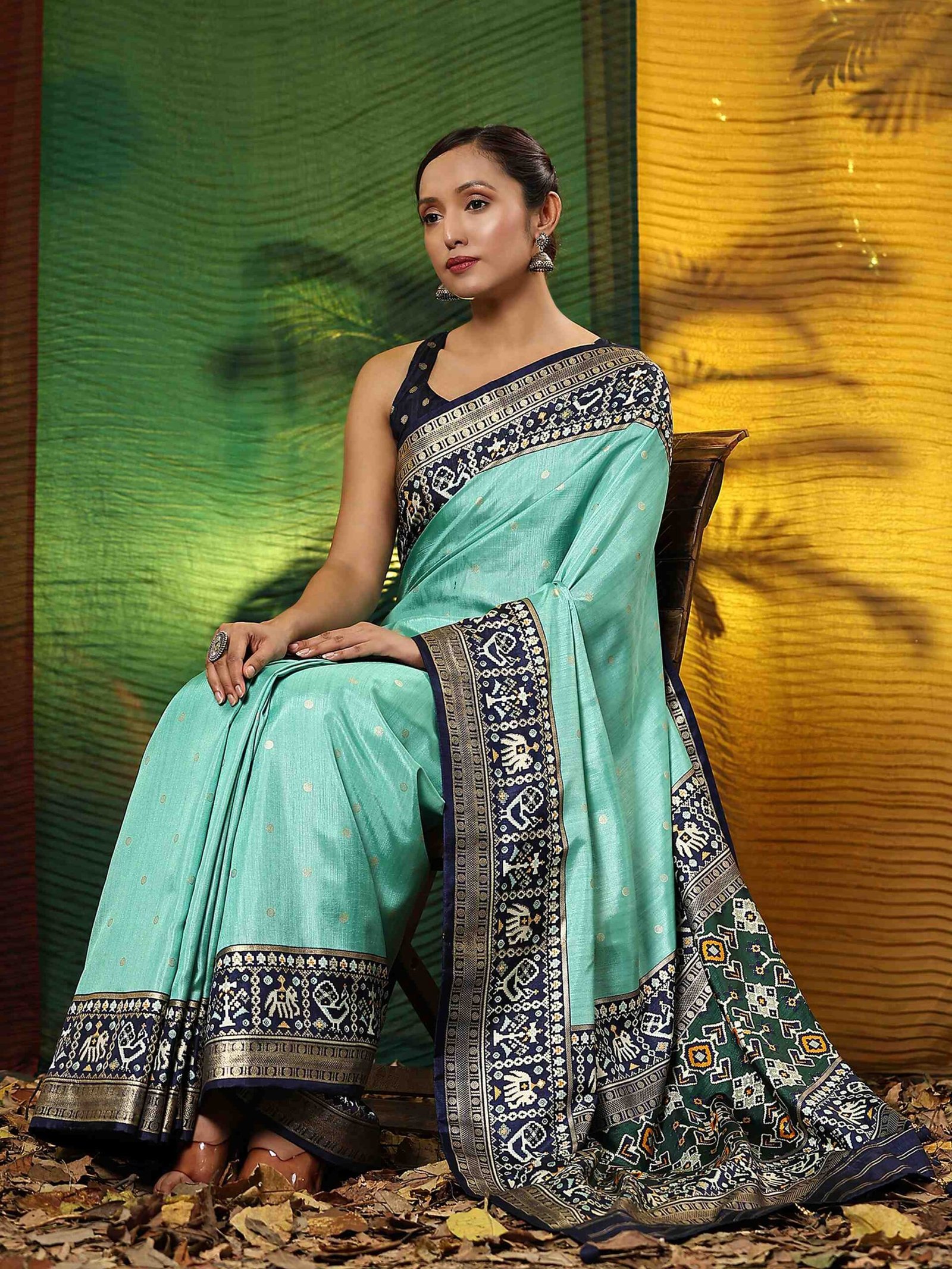Saree are more than just a piece of clothing; they are a reflection of a culture’s heritage, an embodiment of craftsmanship, and a symbol of timeless elegance. Among the countless types of sarees that adorn the diverse landscape of Indian textiles, the Patola silk saree stands out as a masterpiece of artistry and tradition. With a history that spans centuries, Patola silk sarees are celebrated for their intricate designs, vibrant colors, and the painstaking craftsmanship that goes into their creation. In this article, we will explore the world of Patola silk sarees, delving into their history, the unique weaving techniques, the significance of Patola in various Indian cultures, and the enduring appeal of these exquisite garments.
Historical Origins of Patola Silk Sarees


Ancient Roots
The roots of Patola sarees can be traced back to ancient India. The word “Patola” is believed to have its origins in the Sanskrit word “Pattakula,” which means a silk fabric. These exquisite sarees were initially woven in the town of Patan in Gujarat, and the craftsmanship has been passed down through generations. The history of Patola silk sarees dates back over a thousand years.
Influence of Foreign Traders
The trade routes that connected India to various parts of the world played a significant role in shaping the art of Patola weaving. The introduction of new materials, techniques, and designs through interactions with foreign traders, including those from Persia and Indonesia, influenced the development of Patola silk sarees.
Unique Weaving Techniques
Double Ikat Weaving
The hallmark of Patola silk sarees is the double ikat weaving technique, a meticulous process that involves dyeing both the warp and weft threads before they are woven together. The result is a symmetrical and precisely aligned pattern that is identical on both sides of the fabric. This complex method requires exceptional skill and patience.
Skilled Artisans
The creation of Patola sarees is a labor-intensive process that involves a team of highly skilled artisans. These craftsmen and craftswomen meticulously prepare the silk threads, dye them in various colors using natural dyes, and weave them into intricate patterns. The weaving process is so demanding that it can take several months to complete a single saree.
Handmade Perfection
One of the most remarkable aspects of Patola silk saree for women is that they are entirely handmade, with no mechanical assistance. Every step, from dyeing the threads to weaving the patterns, is carried out by hand. This dedication to traditional craftsmanship is what makes Patola sarees truly special.
Significance in Various Indian Cultures
Gujarati Patola Sarees
Gujarat is the epicenter of Patola silk saree production, and these sarees hold immense cultural significance in the region. They are often worn during auspicious occasions, such as weddings and festivals, and are considered a symbol of prestige and heritage. The Patola saree is a treasured heirloom passed down from one generation to the next.
Rajasthani Tie-Dye Patola Sarees
In the neighboring state of Rajasthan, a unique variation of Patola organza saree can be found. These sarees, known for their vibrant tie-dye patterns, are created using a different dyeing technique. Rajasthani Patola sarees are a testament to the adaptability and diversity of Patola artistry across India.
South Indian Patola Influence
The influence of Patola silk sarees extends beyond Gujarat and Rajasthan. In South India, especially in Tamil Nadu and Andhra Pradesh, you can find Patola-inspired silk sarees. These sarees incorporate the double ikat weaving technique but often feature regional design motifs and color palettes.
Enduring Appeal of Patola Silk Sarees

Timeless Aesthetics
The intricate designs, vibrant colors, and symmetrical patterns of Patola silk sarees make them timeless pieces of art. Their appeal transcends generations, and women of all ages cherish the opportunity to own and wear a Patola saree.
Versatility in Fashion
While Patola sarees have deep cultural roots, they are also versatile in their appeal. These sarees are worn on various occasions, from traditional ceremonies to contemporary events. Their adaptability makes them a sought-after choice for fashion enthusiasts.
Investment in Heritage
Patola silk sarees are considered a valuable investment due to their intricate craftsmanship and historical significance. Owning a Patola saree is not just a fashion statement; it is a connection to India’s rich textile heritage and a piece of art that appreciates in value over time.
Sustainable Fashion
In an era of increasing environmental awareness, Patola silk sarees stand out as an example of sustainable fashion. The use of natural dyes, traditional weaving techniques, and long-lasting quality align with the principles of eco-friendly clothing.
Contemporary Trends and Innovations
Revival of Traditional Craftsmanship
In recent years, there has been a revival of traditional weaving techniques, including Patola, in the fashion industry. Designers are collaborating with skilled artisans to create contemporary interpretations of Patola silk sarees, ensuring that this rich tradition continues to thrive.
Fusion of Styles
Modern fashion often blends different cultural elements. Patola sarees are no exception, as they are being combined with various other fabrics and styles to create fusion wear. This trend helps Patola silk sarees find their place in the wardrobes of fashion-conscious individuals.
Conclusion
The Patola silk saree is a testament to the enduring legacy of India’s rich textile heritage. Its history, unique weaving techniques, and significance in various Indian cultures make it a symbol of tradition and artistry. The timeless appeal of Patola silk sarees, combined with their adaptability in contemporary fashion, ensures that they continue to be a cherished part of India’s sartorial landscape. With a Patola saree, one not only wears a piece of clothing but also carries a piece of history, culture, and craftsmanship, making it an everlasting symbol of elegance and heritage.

